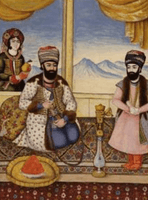Ali Murad Khan
| Ali Murad Khan | |
|---|---|
|
'Vakil e-Ra'aayaa وكيل الرّعايا (Representative of the People) | |
 | |
| Shah of Iran | |
| Reign | 1781-1785 |
| Predecessor | Sadiq Khan Zand |
| Successor | Jafar Khan |
| Born | c. 1720 |
| Died |
11 February 1785 Zand Palace, Shiraz |
| Dynasty | Zand dynasty |
| Father | Allah Morad (Qeytas) Khan Zand Hazareh |
| Religion | Shia Islam |
Ali Murad Khan Zand (c. - 1785) the sixth Shah of the Zand dynasty, reigned from March 15, 1781 until February 11, 1785.

Life
After the death of Karim Khan Zand, Agha Muhammad Khan who was a hostage—in light of preventing an outbreak of war between the Qajar tribes in the northern Persia and the Zands—escaped promptly and reached Mazandaran. Subsequently he took command of his tribe in Astrabad, and declared independence from the Zand Shah. Therefore, Zaki Khan dispatched the Persian army under the command of his nephew, Ali Murad Khan against the Qajar lord.
Ali Murad Khan was given power over the Persian army to destroy Qajar tribes in the north, but he betrayed Abol Fath Khan, and left him defenseless in capital to be slain by Sadiq Khan Zand. Ali Murad then captured Isfahan. He levied high taxes on the people, and tortured and slew whoever refused. Finally on March 14, 1781 he captured Shiraz, and slew Sadiq Khan, and sat on the throne. Murad continued the war with Agha Mohammad Khan and raised an army allowing his cousin Rustam to command it. Rustam took this army to the province of Mazandaran where he fought against a Qajar army under the command of Ja'far Quli Khan. However Rustam quickly lost the battle and was forced to retreat back to the south.[1]
Ali Murad Khan ruled until 1785, when he was overthrown by Sadiq's son Jafar.
Sources
- Hambly, Gavin R.G (1991). "Agha Muhammad Khan and the establishment of the Qajar dynasty". The Cambridge History of Iran, Vol. 7: From Nadir Shah to the Islamic Republic. Cambridge: Cambridge University Press. pp. 104–144. ISBN 9780521200950.
External links
References
| Political offices | ||
|---|---|---|
| Preceded by Sadiq Khan Zand |
Shah of Persia 1781–1785 |
Succeeded by Jafar Khan Zand |